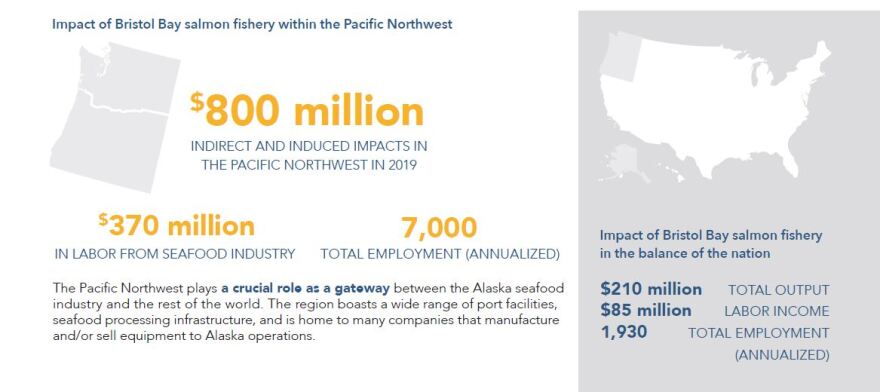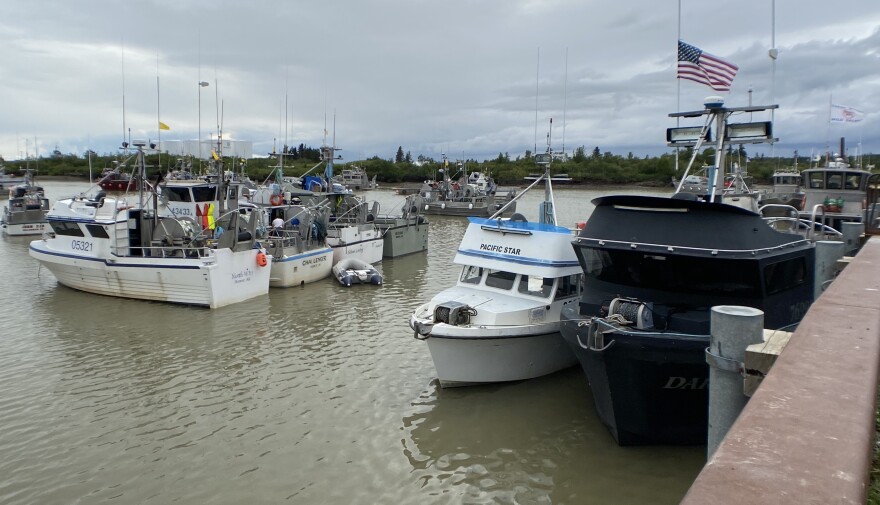A recent study by the McKinley Research Group estimates that Bristol Bay’s commercial salmon industry generated $2 billion in economic benefit and an average of 15,000 jobs in 2019. The 57-page study was published in February by “Bristol Bay Defense Fund,” a coalition of regional Tribes, businesses and conservation groups that support permanent federal protections at the region's headwaters.
The new report, called “The Economic Benefits of Bristol Bay Salmon," bridges a three year gap in analyzing the value of the region's salmon industry. Rebecca Braun is with McKinley Research Group and worked on the new report.
“The most recent time was published in 2018," said Rebecca Braun, who is with McKinley Research Group and worked on the new report. "It mostly relied on 2016 data cause of a lag. This group was interested in updating the numbers and expanding what we looked at and we were kind of excited about that too.”
Braun, with others, gathered data from 10 different sources including the Alaska Department of Fish and Game, the state Department of Revenue and NOAA fisheries.
She and a team of others calculated that Bristol Bay’s commercial fishery was valued at $2 billion and supported 15,000 jobs in 2019 -- according to the latest data available. That’s nearly double what consultants evaluated it at in the prior report.

The coalition that published the report, Bristol Bay Defense Fund, says the study’s findings support their call for permanent federal protections at the regions’ headwaters from mining projects like Pebble Mine. Katherine Carscallen represents Commercial Fishermen for Bristol Bay. She commercial fishes and lives in Dillingham.
“While we’ve spent so much energy fighting this mine, we’ve also put quite a bit of effort into building this fishery," she said. "My hope is that it highlights the need to just put this issue to bed so we can continue focusing on building the economy that makes sense for Bristol Bay.”
The report says that of the $2 billion generated by the region’s fishery, $990 million stays within Alaska. The rest comes from port facilities, seafood processors and equipment providers in the Pacific Northwest.
Braun said the report measures these values by looking at direct, indirect and induced impacts.
“Direct economic impact are the jobs and income earned by those directly engaged in commercial fishing, seafood processing. Indirect impacts are the jobs and payrolls in support sectors," she said. "Basically, people who are fishing and processing, they purchase a whole range of goods and services in support of their operations.”
The support sector of the fishery refers to air taxis, refrigeration technicians, net builders, welders and other related businesses. That third category -- induced impacts -- is how industry workers spend their earnings.

As for the commercial salmon fisheries' impact on jobs, the study found that 8,500 harvesters worked in Bristol Bay in 2019. Half of those either lived in region or other parts of the state. About 6,000 people were employed in processing plants. The bulk of those processors traveled from out of state.
Andy Wink is the CEO of the Bristol Bay Regional Seafood Development Association. Wink also supports permanent protections for the region. He talked about the report at a recent panel during “ComFish,” an annual trade show in Kodiak. He said those jobs represent an average monthly employment figure.
“It’s important to note that this is not a number of workers because this is a seasonal fishery," Wink said. "With 15,000 jobs that is roughly the same amount as employment of all the federal government employees in Alaska. It takes a huge amount of people both to catch all this fish and to process it, get it frozen, get it canned, and get it shipped out fresh.”

In 2019, harvesters in Alaska earned a total of $294 million in salaries, wages, and commissions, or as the report calls it “labor income.” Processors, meanwhile, earned a combined $81 million.
Wink compared those numbers to an annual report in from the state’s Census of Employment and Wages in 2019.
“At $375 million in labor income, that is slightly more than all of the wages and salaries in the non-oil and gas mining sector in Alaska or the same size of the Ketchikan borough in terms of salary and wages,” he said.
In the report, other benefits from the commercial fishery include a share of the Fisheries Business Tax to Bristol Bay communities. A third of the Bristol Bay Borough’s total revenue came from that share in 2019. The Borough also uses a Raw Fish tax to pay for sewer upgrades and repairs. The Lake and Peninsula Borough also collects a Raw Fish tax.
Unlike the two boroughs, Dillingham does not have a raw fish tax. But the city has reported a three year average of $617,000 from the Fisheries Business Tax.
Wink said the report reflects how important Bristol Bay’s fishery is to the seafood industry in Alaska. He attributes recent record breaking salmon runs to the increase in value.
“Bristol Bay has kinda been the shining star of salmon fisheries in Alaska for the last several years," Wink said. "And in 2018 and 2019, it was over 50% of Alaska’s entire salmon value. I think that’s important to keep in our minds as we think about protections for Bristol Bay. If those protections aren’t there, it’s not hyperbole to say the entire Alaska salmon industry is at risk. ”
The industry continues to grow. And Bristol Bay’s projected forecast for the sockeye run this year is expected to exceed 51 million fish. The run has averaged at least 50 million fish in the last five years.
Contact the author at tyler@kdlg.org or 907-842-2200




